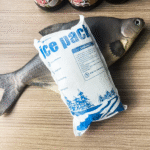In cold chain logistics, the reliability of temperature control is paramount. For businesses handling sensitive products, such as pharmaceuticals, food, or biological samples, choosing the right refrigerant solution is critical. Extra cold dry ice packs stand out as a superior choice, providing long-lasting cooling to maintain ultra-low temperatures throughout the shipping process. In this comprehensive guide, we will explore everything you need to know about extra cold dry ice packs—how they work, their benefits, and how they can optimize your cold chain strategy.

What Are Extra Cold Dry Ice Packs?
Extra cold dry ice packs are specialized refrigeration solutions made from solid carbon dioxide (CO₂). Unlike traditional ice, dry ice sublimes directly from a solid to a gas without passing through a liquid phase. This process absorbs significant heat, making these packs perfect for maintaining temperatures as low as -78.5°C (-109.3°F). Their ability to stay colder for longer durations makes them ideal for shipping temperature-sensitive goods like vaccines, perishable foods, and medical supplies over long distances.
Extra cold dry ice packs ensure that sensitive items remain at their required temperature for extended periods, even during long shipping durations. These packs are indispensable in industries where maintaining a precise temperature is not just important but critical to the integrity of the product.
How Do Extra Cold Dry Ice Packs Work?
Extra cold dry ice packs work by leveraging the sublimation of CO₂ to absorb heat and keep surrounding items frozen. When dry ice is placed in an insulated container, it begins to sublimate, transitioning directly from a solid to gas, which absorbs heat and keeps the temperature inside the container ultra-low.
Unlike regular ice, which can melt and produce water, dry ice leaves no residue, making it the ideal solution for sensitive goods like electronics, vaccines, and lab specimens. This phase change provides consistent cooling over extended periods, helping businesses meet shipping deadlines while ensuring that products arrive in optimal condition.
Benefits of Extra Cold Dry Ice Packs
-
Extended Cooling Duration: Extra cold dry ice packs can maintain extremely low temperatures for up to 72 hours or longer, depending on the size of the pack, insulation, and environmental conditions.
-
Superior Cooling Power: These packs can reach temperatures far below what traditional ice can achieve, providing a better solution for products that need to stay frozen or ultra-cold.
-
No Melting Water: Since dry ice sublimates rather than melts, there’s no water to damage your products or packaging, making it the ideal solution for electronics, biological samples, and other sensitive items.
-
Cost-Efficiency: Although initially more expensive than regular ice, the extended cooling duration of extra cold dry ice packs reduces the frequency of replenishments, making them a cost-effective option in the long term.
Key Applications of Extra Cold Dry Ice Packs
Pharmaceutical Shipping
Extra cold dry ice packs are essential in the pharmaceutical industry for shipping temperature-sensitive medications such as vaccines, biologics, and insulin. Products like these require strict temperature control during transit, and even a slight temperature fluctuation can compromise their effectiveness. Extra cold dry ice ensures that these products remain within the required temperature range for the duration of the shipping process.
Food and Beverages
For the food industry, especially in the transportation of frozen foods, ice cream, and meat products, extra cold dry ice packs are invaluable. These packs maintain the required low temperatures during long-distance shipments, ensuring that perishable goods remain fresh and safe for consumption upon arrival.
Biological Samples and Research
Research institutions and laboratories rely heavily on extra cold dry ice to preserve biological samples, chemicals, and other sensitive research materials. The ultra-low temperatures provided by dry ice are necessary to maintain the integrity of the samples and prevent any degradation during transport.
How to Use Extra Cold Dry Ice Packs Effectively
To maximize the effectiveness of extra cold dry ice packs, several factors must be considered:
1. Proper Packaging and Insulation
Ensure that dry ice packs are placed in well-insulated containers to slow down the sublimation process and extend the cooling duration. Use high-quality packaging materials like vacuum-insulated panels (VIPs) or thick foam to minimize heat exposure.
2. Ventilation
While dry ice is effective at cooling, it releases carbon dioxide gas as it sublimates. Proper ventilation is necessary to ensure the gas doesn’t accumulate in confined spaces, as it could displace oxygen and cause asphyxiation.
3. Handling Safety
Always handle dry ice with insulated gloves to prevent frostbite or skin damage from its extreme cold. Never touch dry ice directly with bare skin.
Extra Cold Dry Ice Packs vs. Regular Dry Ice Packs: What’s the Difference?
| Feature | Extra Cold Dry Ice Packs | Regular Dry Ice Packs |
|---|---|---|
| Temperature Range | -78.5°C | -55°C |
| Cooling Duration | 72+ hours | 24-48 hours |
| Use Case | Pharmaceuticals, biologics, long-haul | General perishable goods |
| Cost | Higher | Lower |
As seen in the table above, extra cold dry ice packs provide much lower temperatures and longer cooling durations than regular dry ice packs, making them the ideal choice for sensitive shipments that need to remain frozen for longer periods.
Safety Considerations When Using Extra Cold Dry Ice Packs
To ensure the safe use of extra cold dry ice packs, follow these important guidelines:
-
Storage: Store dry ice in well-ventilated areas and avoid placing it in airtight containers to prevent the buildup of carbon dioxide gas.
-
Handling: Always wear insulated gloves when handling dry ice to prevent injuries from its extreme cold.
-
Disposal: Allow dry ice to sublimate in a well-ventilated space. Never dispose of it in water or sealed containers.
The Future of Extra Cold Dry Ice Packs in Cold Chain Logistics
Emerging trends are reshaping how extra cold dry ice packs are used in logistics:
-
Biodegradable Alternatives: Growing demand for sustainability has led to the development of biodegradable alternatives to traditional dry ice.
-
Smart Packaging: Temperature-monitoring sensors integrated into packaging will enhance real-time tracking and improve cold chain management.
-
AI Integration: Artificial intelligence may soon play a larger role in automating temperature control and ensuring optimal conditions throughout the shipping process.
These innovations will continue to improve the efficiency, cost-effectiveness, and sustainability of extra cold dry ice packs in cold chain logistics.
Frequently Asked Questions (FAQ)
Q1: How long do extra cold dry ice packs last?
Extra cold dry ice packs typically last 24-72 hours, depending on the insulation, pack size, and shipping conditions.
Q2: Are extra cold dry ice packs safe to handle?
Yes, but always use insulated gloves when handling them to avoid frostbite, and ensure proper ventilation to prevent CO₂ buildup.
Conclusion
Extra cold dry ice packs are an indispensable tool in cold chain logistics, ensuring that temperature-sensitive goods are transported safely and efficiently. Their ability to maintain ultra-low temperatures for extended periods makes them ideal for pharmaceuticals, biological samples, and perishable food shipments.
Next Steps
-
Evaluate your shipping needs and consider incorporating extra cold dry ice packs into your logistics process.
-
Ensure proper insulation and temperature monitoring for optimal performance.
About Tempk
At Tempk, we specialize in providing high-performance cold chain solutions, including extra cold dry ice packs. Our products are designed to meet the highest standards of temperature control, ensuring the safe transport of your most sensitive goods.
For expert advice on optimizing your cold chain logistics, contact us today!























